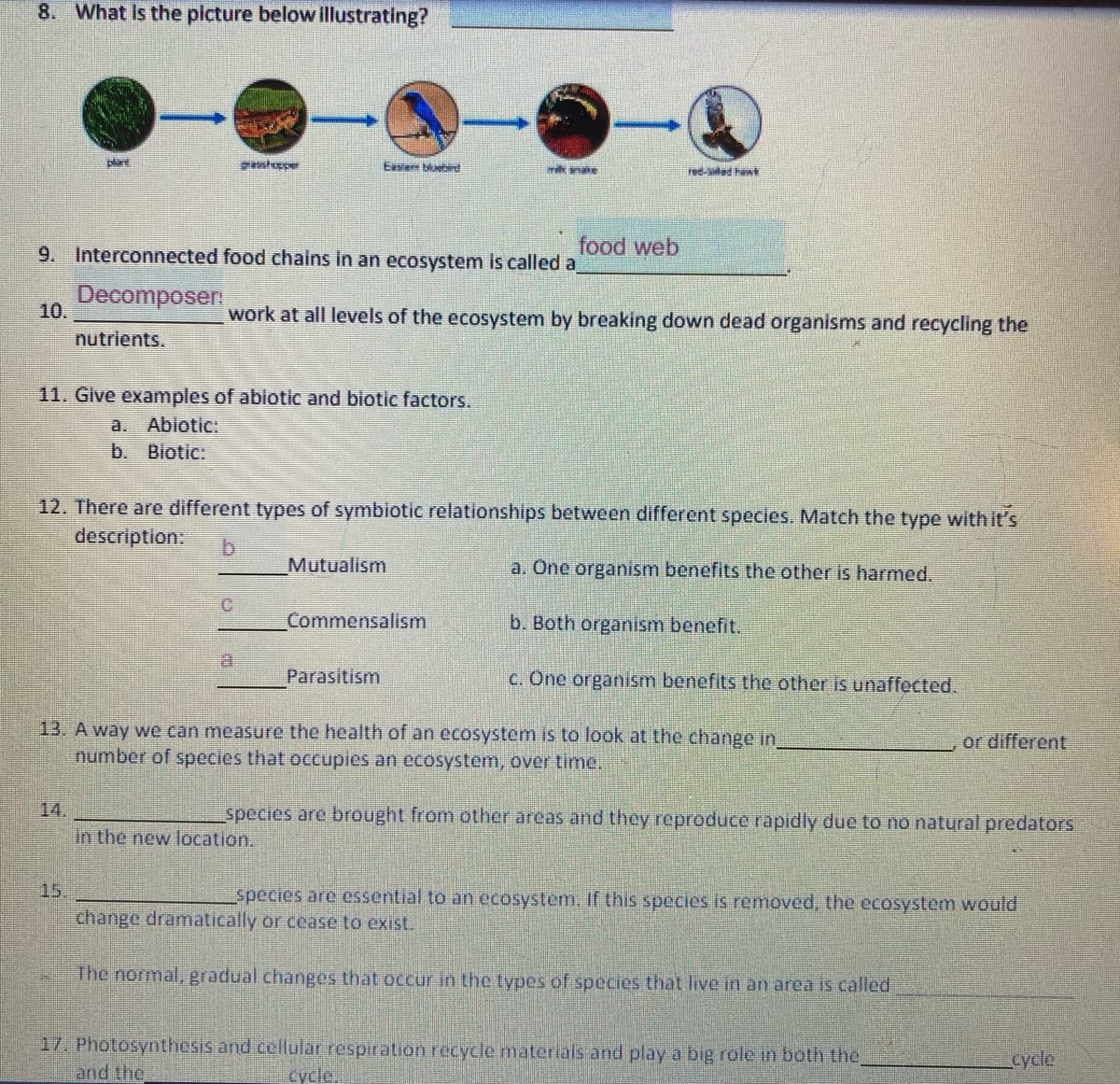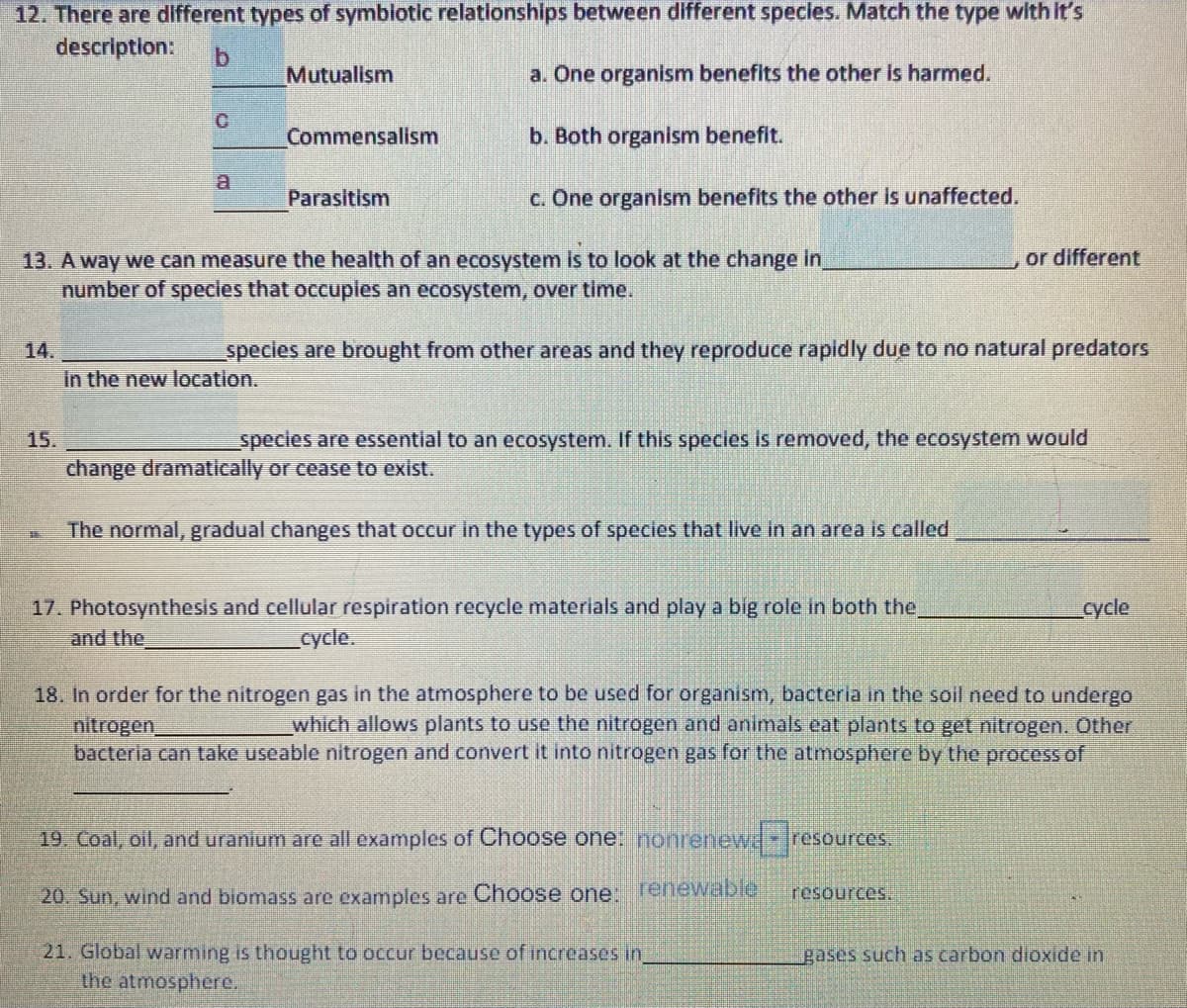8. What Is the plcture below illustrating? plart Easier bluebird red-aled huwk 9. Interconnected food chains in an ecosystem is called a food web Decomposer 10. work at all levels of the ecosystem by breaking down dead organisms and recycling the nutrients. 11. Give examples of abiotic and biotic factors. a. Ablotic: b. Biotic:
8. What Is the plcture below illustrating? plart Easier bluebird red-aled huwk 9. Interconnected food chains in an ecosystem is called a food web Decomposer 10. work at all levels of the ecosystem by breaking down dead organisms and recycling the nutrients. 11. Give examples of abiotic and biotic factors. a. Ablotic: b. Biotic:
Biology: The Dynamic Science (MindTap Course List)
4th Edition
ISBN:9781305389892
Author:Peter J. Russell, Paul E. Hertz, Beverly McMillan
Publisher:Peter J. Russell, Paul E. Hertz, Beverly McMillan
Chapter54: Ecosystems And Global Change
Section: Chapter Questions
Problem 10TYK: Which of the following statements is supported by the results of studies at the Hubbard Brook...
Related questions
Question
100%
Fill in the blanks

Transcribed Image Text:8. What Is the plcture below illustrating?
Easier bluebird
red-led huwk
9. Interconnected food chains in an ecosystem is called a
food web
Decomposer
10.
work at all levels of the ecosystem by breaking down dead organisms and recycling the
nutrients.
11. Give examples of abiotic and biotic factors.
a. Abiotic:
b. Biotic:
12. There are different types of symblotic relationships between different species. Match the type with it's
description:
Mutualism
a. One organism benefits the other is harmed.
Commensalism
b. Both organism benefit.
Parasitism
C. One organism benefits the other is unaffected.
13. A way we can measure the health of an ecosystem is to look at the change in
number of species that occupies an ecosystem, over time.
or different
14.
in the new location.
species are brought from other areas and they reproduce rapidly due to no natural predators
15.
Species are essential to an ecosystem. If this species is removed, the ecosystem would
change dramatically or cease to exist.
The normal, gradual changes that occur in the types of species that live in an area is called
17. Photosynthesis and cellular respiration recycle materials and play a big role in both the
and the
cycle
cycle,

Transcribed Image Text:12. There are different types of symbiotic relationships between different specles. Match the type with It's
description:
b.
Mutualism
a. One organism benefits the other Is harmed.
Commensallsm
b. Both organism benefit.
Parasitism
c. One organism benefits the other is unaffected.
or different
13. A way we can measure the health of an ecosystem is to look at the change in
number of species that occuples an ecosystem, over time.
14.
species are brought from other areas and they reproduce rapidly due to no natural predators
in the new location.
15.
specles are essentlal to an ecosystem. If this species is removed, the ecosystem would
change dramatically or cease to exist.
The normal, gradual changes that occur in the types of species that live in an area is called
17. Photosynthesis and cellular respiration recycle materials and play a big role In both the
cycle
and the
cycle.
18. In order for the nitrogen gas in the atmosphere to be used for organism, bacteria in the soil need to undergo
nitrogen
bacteria can take useable nitrogen and convert it into nitrogen gas for the atmosphere by the processof
which allows plants to use the nitrogen and animals eat plants to get nitrogen. Other
19. Coal, oll, and uranlum are all examples of Choose one: nonrenew-resources.
20. Sun, wind and biomass are examples are Choose one:
renewable
resources.
21. Global warming is thought to occur because of increases in
the atmosphere.
gases such as carbon dioxide in
Expert Solution
This question has been solved!
Explore an expertly crafted, step-by-step solution for a thorough understanding of key concepts.
This is a popular solution!
Trending now
This is a popular solution!
Step by step
Solved in 2 steps

Knowledge Booster
Learn more about
Need a deep-dive on the concept behind this application? Look no further. Learn more about this topic, biology and related others by exploring similar questions and additional content below.Recommended textbooks for you

Biology: The Dynamic Science (MindTap Course List)
Biology
ISBN:
9781305389892
Author:
Peter J. Russell, Paul E. Hertz, Beverly McMillan
Publisher:
Cengage Learning

Biology 2e
Biology
ISBN:
9781947172517
Author:
Matthew Douglas, Jung Choi, Mary Ann Clark
Publisher:
OpenStax

Biology (MindTap Course List)
Biology
ISBN:
9781337392938
Author:
Eldra Solomon, Charles Martin, Diana W. Martin, Linda R. Berg
Publisher:
Cengage Learning

Biology: The Dynamic Science (MindTap Course List)
Biology
ISBN:
9781305389892
Author:
Peter J. Russell, Paul E. Hertz, Beverly McMillan
Publisher:
Cengage Learning

Biology 2e
Biology
ISBN:
9781947172517
Author:
Matthew Douglas, Jung Choi, Mary Ann Clark
Publisher:
OpenStax

Biology (MindTap Course List)
Biology
ISBN:
9781337392938
Author:
Eldra Solomon, Charles Martin, Diana W. Martin, Linda R. Berg
Publisher:
Cengage Learning

Biology: The Unity and Diversity of Life (MindTap…
Biology
ISBN:
9781337408332
Author:
Cecie Starr, Ralph Taggart, Christine Evers, Lisa Starr
Publisher:
Cengage Learning

Biology: The Unity and Diversity of Life (MindTap…
Biology
ISBN:
9781305073951
Author:
Cecie Starr, Ralph Taggart, Christine Evers, Lisa Starr
Publisher:
Cengage Learning